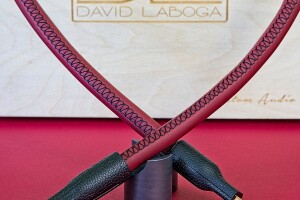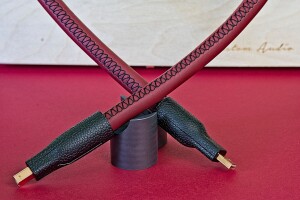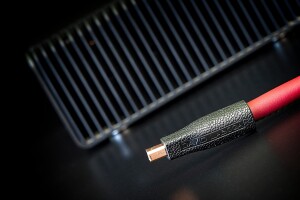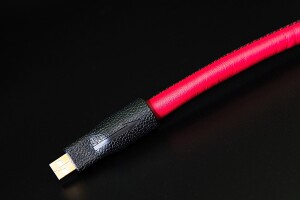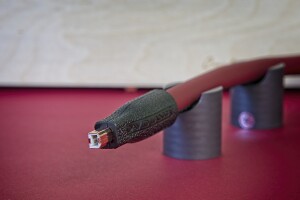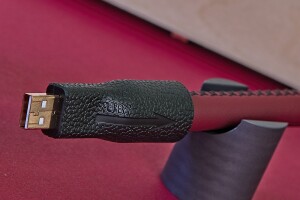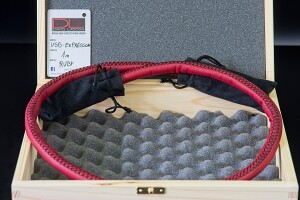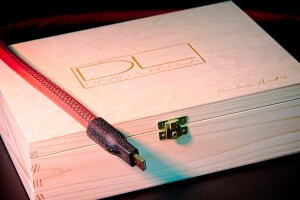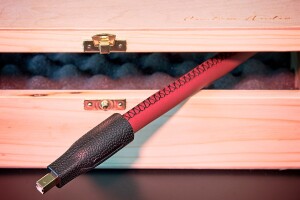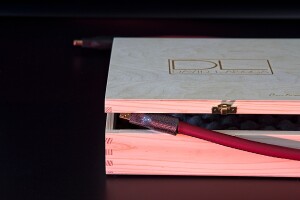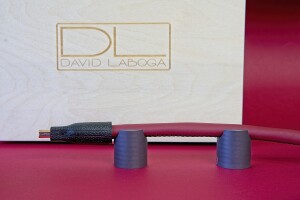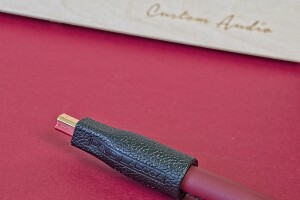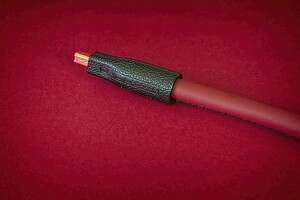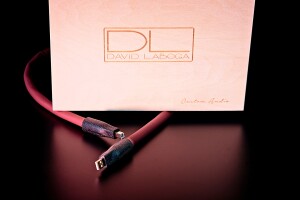After the excellent, even though only „entry-level” Emerald the time has come to take on the top model from the same manufacturer, the David Laboga Expression Ruby USB. It looks like million bucks with its ruby leather sleeving and custom plugs, so the only question remaining is whether its performance equals the exclusive make&finish.
Introduction
I’ve shared already a lot of information regarding David Laboga’s company in my Expression Emerald USB cable review, which was my first encounter with this brand’s product. So if you want to know more, please follow the link HERE. Not to repeat myself but to still give very basic information to those, who haven’t read the aforementioned review, let me just say, that the brand has been known for many years among professionals. By professionals, I mean both musicians and „the men behind the glass” in the recording and mastering studios not only in Poland but also around the world. Actually, it is probably better known outside our country than here. Many guitar virtuosi have been using David Laboga’s guitar cables. Also, numerous people in the recording industry experienced first-hand advantages of these cables being used not only by musicians but also in the studios’ setups.
Relatively recently, David Laboga has decided to target a new group of potential customers, namely us, audiophiles. Don’t you worry, he did it in a very sensible way, researching the expectations of his new customers first, and using his extensive experience to prepare a separate lineup just for us. To be honest, I found it quite surprising to see how quickly the offer became quite extensive. It seems that today one may choose any type of cable needed in an audio setup from David Laboga. There is quite a selection of analog cables – interconnects (both balanced and unbalanced) including phono cables, speaker cables, jumpers, and also power cables, as well as a digital sort, from USB (as the Expression as mentioned earlier Emerald) and Ethernet (you can read a review of the Digital Sound Wave Sapphire HERE), to S/PDIF coaxial and AES/EBU cables.
As one finds in the brand’s price list, there is a significant difference between what one has to pay for entry-level models and the top ones. The former may not belong to the cheapest on the market but are definitely reasonably priced (especially, as the Expression Emerald proved, considering an excellent price/quality ratio), the latter will drain your pocket or bank account significantly, but to a much lesser extent than top proposals from the big industry’s tycoons. As I learned from my conversations with Mr. David, the lineup is so extensive to allow potential customers to find what they look for both in terms of sonic character and quality and what they can afford to pay. The key element that allowed the development of so many models was the huge knowledge and experience of the designer, who claims that he is able to build a cable fitting precisely any customer’s requirements, assuming that they are clearly expressed, obviously.
He is able to achieve that by means of various components and conductors, special cable design, and meticulous make and finish – each cable is made by hand! Hence, DL Cables is one of those rare audio manufacturers, who don’t tell customers what’s good for them, or what sound is the right/correct one, but rather try to offer the closest possible match to customer’s individual needs or expectations. That is why, for example, analog interconnects are offered with gold- and rhodium-plated plugs. Despite all other components and conductor material being exactly the same, ICs fitted with plugs with contact areas covered with gold and those with rhodium sound different, hence better satisfying particular customers’ needs.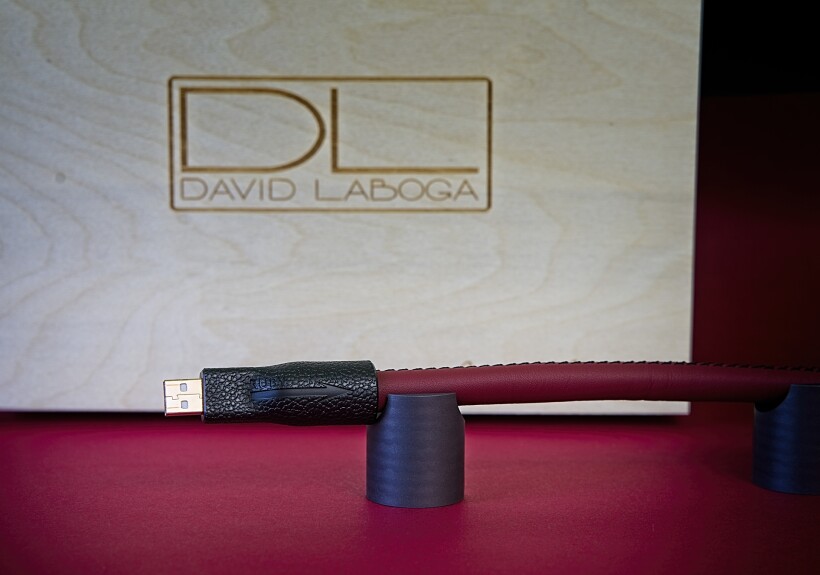
When it comes to phono cables (those terminated with RCA plugs on both ends) one can order a pair with gold-plated plugs at one end and rhodium-plated at the other and choose by ear which direction of connection sounds better for him or her. These are not elements one finds often in famous cable brands’ lineups because even if they offer interconnects with various plugs these are most often different models, so there are more differences than just plugs. I guess, this feature of David Laboga cables alone should attract the attention of those music lovers who look for solutions best matching their individual sonic preferences.
A short side note. A while ago I suggested one of my friends, who was asking about my cable recommendations, contacting Mr. Laboga. I later learned from him, that our designer had quite a long conversation with him to find out as much as possible about his system, sonic and musical preferences and only then suggested particular models that in his opinion would suit my friend’s needs best (and just so you know, these were not the top of the range ones). I don’t know about you but I highly appreciate such a customized approach to customer’s needs.
My personal experience with David Laboga cables started with digital, entry-level USB and mid-level Ethernet, cables and now the top-of-the-line Expression Ruby USB is sort of a continuation of this exciting adventure. Previous experiences proved that this is a highly interesting manufacturer so I don’t mind discovering more of his products. Actually, I’ve already got a power cable for yet another review, and it’s been breaking in in my system for a while already, so you can expect the next review within a few weeks. Let’s get to the point: how good is the gorgeous Ruby USB? Does the performance match appearance? Keep reading to find out my assessment.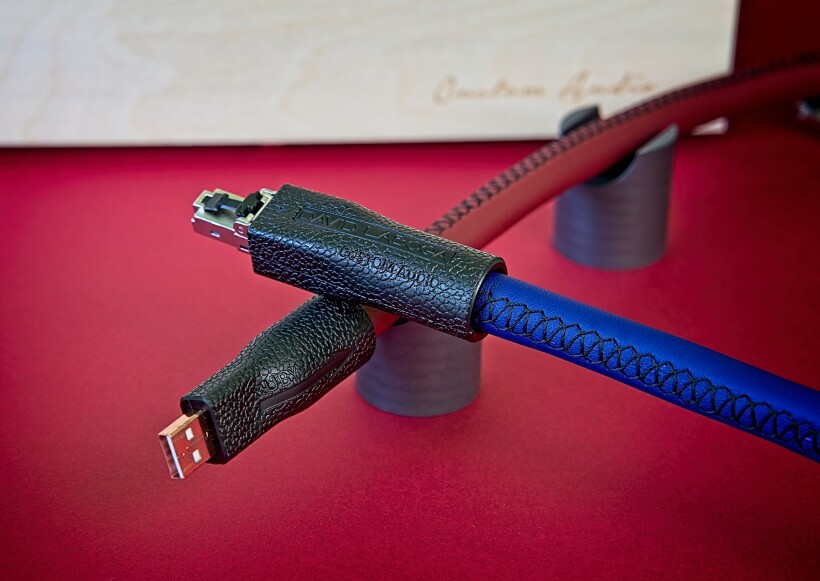
Design
Ruby, as befits the top-of-the-range model, offers an exclusive vibe from the very first moment one lays eyes (and hands) on it. And it comes from a man, who doesn’t even particularly like leather. Why leather, you may ask? Well, because, similarly to the aforementioned Digital Sound Wave Sapphire Ethernet cable, also Ruby’s sleeving is hand-made of natural leather, just not blue/sapphire this time but rather dark red/ruby. Maybe the packaging it comes in, a simple, well-made wooden box with an engraved logo, is not that impressive, but the cable itself simply has to speak to the aesthetic sensitivity of those who love beautiful products. The endings on both sides, the last short pieces partially covering plugs, are made of nicely contrasting black leather. Next to the B-type plug, or the DAC end of the cable, the black finishing piece of leather features an embossed inscription – „David Laboga” – and next to it there is a miniature genuine ruby stone – a cherry on the top, so to speak.
The top-of-the-line hand-made cable asked for bespoke, top-quality plugs, and that’s what it got. The custom plugs are made of copper and the contact areas are gold-plated but using a special, so-called, rose gold. Due to the exclusive finish and bigger conductor diameter Ruby is a bit less flexible than Emerald, but still enough not to cause any problems when installing in the system. The cable is terminated with an A-type USB plug on one end and a B-type on the other which determines its directivity. The Ruby, same as other David Laboga USB cables, is available in two versions – with or without the 5V power wire. Details of the cable’s design remain the company’s secret – they see no reason to make competitors’ life easier. What we know is that each unit is braided of hand-made copper conductors of various purity and AWG (!), which is quite a unique approach. Obviously, the parameters of the conductors, and all other components, are selected to achieve the required, top-quality performance. The break-in period for Ruby USB, according to the manufacturer, takes a minimum of 100 hours, but the best results are achieved after 200. The standard lengths of Expression Ruby USB are: 20, 50, 100, 150, 200, and 300 cm. Custom lengths are available upon request.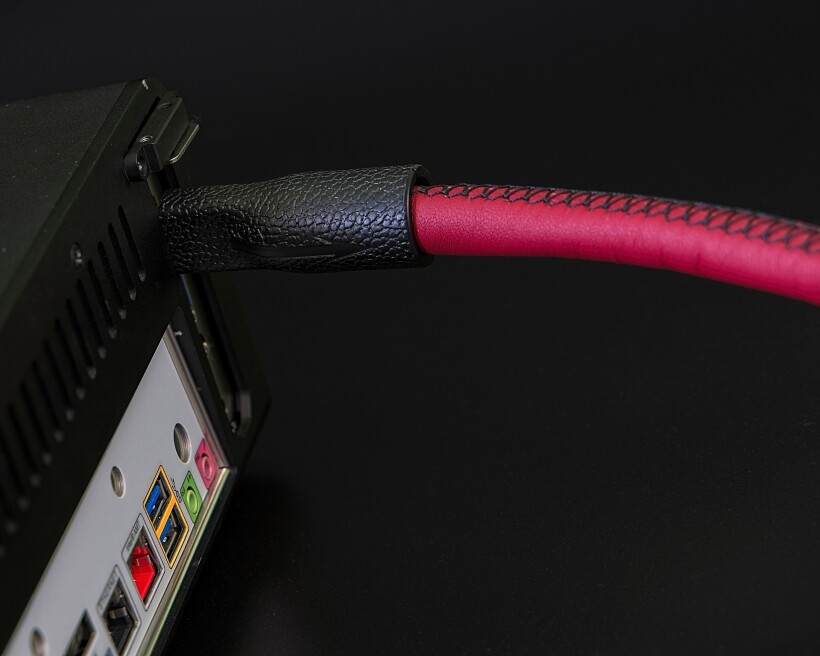
Sound
After the Expression Emerald USB test, I bought two of these cables for my system, because firstly, even this entry-level model offers a beautifully natural, non-digital, high-quality sound and secondly, compared to many competitors, also an excellent sound quality to price ratio. I do realize that it is not the “best cable in the world” (no such thing anyway), but I am one of those people who are always looking for products that offer particularly good, even if not the best possible, sound for a reasonable price. Hence the choice. As David himself admitted, this model is to be the choice of most customers, and the more expensive ones are to be chosen by those who have the most expensive, and the best systems. He means those who are ready to spend a lot for any further improvement in the sound quality while being fully aware of the principle of diminishing returns – a big increase in price is not equally reflected in how much performance improves. That’s how high-end audio works.
When I talked to him, our designer did not want to quantify the sound quality difference between all three models. He only claimed that the cheapest (Emerald) is already excellent and will be perfect for most systems(which I can confirm now from experience), but those who choose more expensive ones will notice a further, gradual improvement in the sound quality with each model. So it was up to me to determine what kind or level of improvement, if any, Ruby has to offer compared to Emerald. I performed the test in my reference system using my custom server supported with the recently reviewed top version of the JCAT USB card, the XE model, combined with the excellent Ferrum HYPSOS power supply (review pending) and the top LampizatOr Pacific DAC.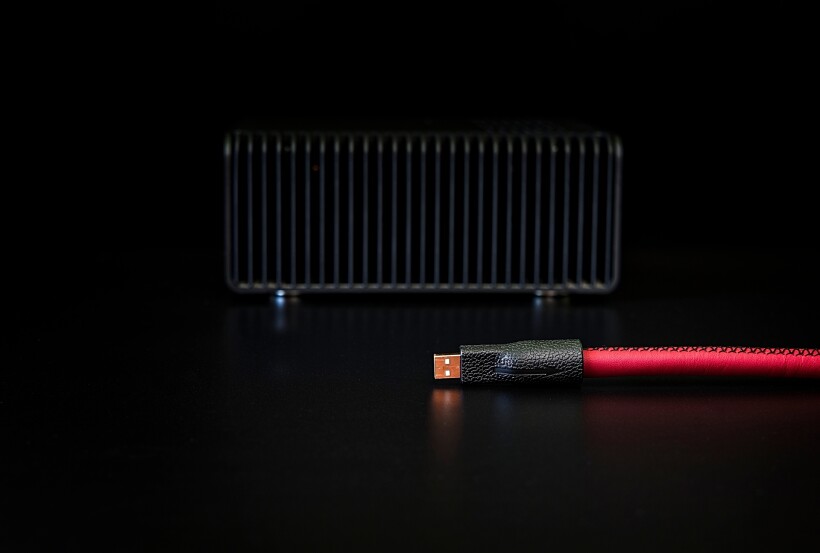
For a couple of weeks before this test, I have been using the Ethernet connection between my server and the DAC (using the excellent David Laboga Digital Sound Wave Sapphire cables and the JCAT NET XE card), so I decided to start with “refreshing” my memory and spending a day with the Expression Emerald USB and to start comparing the cables only a day or so later. The result of replacing the entry-level model with the top one turned out to be quite surprising. After all, one expects a spectacular difference between these two models, doesn’t he? Well, it wasn’t. Spectacular, I mean. Not because there wasn’t any audible difference, or because there was only a small one, but because of the direction of the changes. Although, in fact, I should rather describe what happened as “improvement”, not a change, as the latter may imply that the sound took a different direction, that its character changed, and that it wasn’t so at all.
When I talked to Mr. David a few days later he told me, that all his models share a similar sound character, and certain sets of features are constant. However, each more expensive model offers more of or improved/enhanced features of the less expensive one. In other words, we are talking about evolution, about building upon a strong foundation already the least expensive model has to offer, and developing/improving its advantages instead of creating a completely „different sound” for each cable. So once you know one representative of the line, say the Expression, you know them all – it’s just a matter of the more expensive ones being „better/bigger/faster/more”.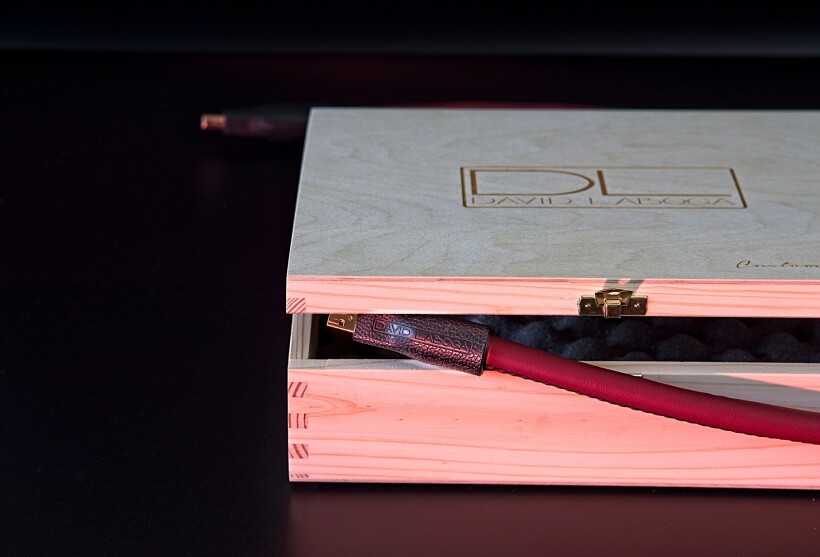
Those who read my review of the Emerald may remember what was the first thing that caught my attention when I was listening to it. I was astonished by how fluid, open, effortless, and natural the presentation was with it. Does Ruby serve the same first impression? Actually, in direct comparison, I paid attention to something else, which does not mean that for someone for whom this will be the first contact with David Laboga’s USB cables, the aforementioned features can not be the ones creating the first impression. Because with Expression Ruby they are again one of the keys but elevated to a new, absolutely fantastic level, features. When, however, I listened to Ruby vs Emerald head-to-head comparison, something else grabbed my attention first. It seemed as if the presentation with the top model became calmer, smoother, and even more relaxed. Could it be a lack of energy or diminished dynamics of the presentation? That may be the first impression but after a while one realizes that it’s not like that, not like that at all (!). If you just go with quick A/B/A comparison switching cables every one or two minutes, you won’t be able to fully appreciate what David Laboga has achieved with his top USB cable and this first (wrong) impression may be what you’re left with.
This would be a shame because after a while there is no question of diminished dynamics or energy of the presentation, and I didn’t have to play AC/DC (although later I did) album to find out about it. All I needed was an acoustic concert of the Bill Laurence Trio to appreciate the enormous potential of the tested cable in this regard. Of course, in such recordings, events in the micro-scale are more important and more impressive, but they are usually even more difficult to reproduce than what happens in the macro scale. With Ruby, I could perfectly hear the differences between the individual plucks of the double bass strings, or strikes on the electric bass strings, drum membranes, cymbals, or piano keys. It is the perfect differentiation, not only in terms of dynamics but also timbre, which is one of the key distinguishing features of the top cables, such as Ruby. With the cheaper ones it may seem that there is nothing left to show, no room for improvement in this respect, but when a cable such as Ruby gets a chance, even though the change does not seem spectacular at first, the longer we listen to the music with it, the more we appreciate its potential and how it is able to improve listener’s experience.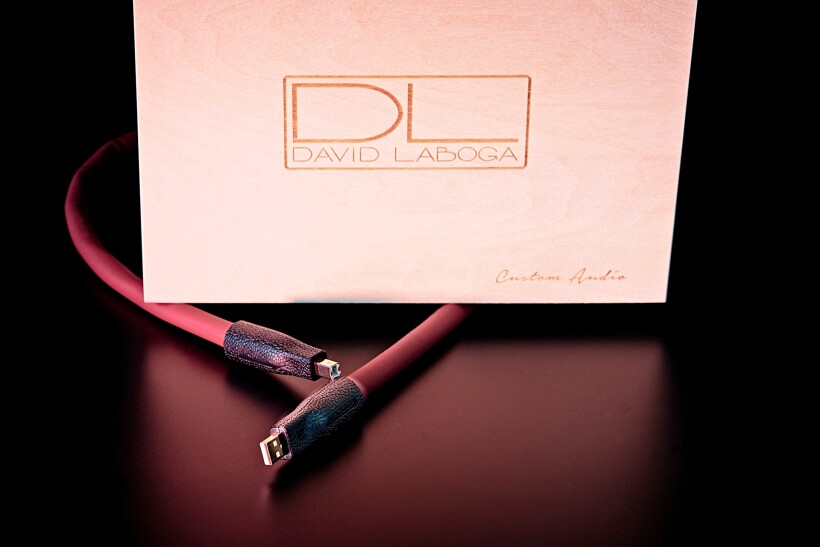
Thanks to such an excellent differentiation, the sound with the Expression Ruby was definitely richer, fuller, and therefore simply more realistic. Compared to the already great-sounding Emerald, Ruby offered also an even smoother and more coherent presentation, or in other words one more similar to the sound of live instruments, and therefore more natural. And now, let’s circle back to the Emerald and the similarities between these models. It is the aforementioned even better fluidity, coherence, and even more organic nature of the sound, that initially contribute to the impression of lower dynamics or energy. The point is that sound is even more relaxed, but it is a result of Ruby’s even better control and organization of the entire presentation. With it everything has its place, there is no nervousness or uncertainty in the sound and everything is exactly where and as it should be. The dynamics and energy become proper elements of a whole, enriching it without overwhelming it, instead of being distinguishing features. Hearing that listener (involuntarily) relaxes more and perception of the sound is just easier, better, and more natural. The cheaper David Laboga’s USB cable absolutely does not sound mechanical or digital, but when you hear the Expression Ruby, it is clear that the sound with it becomes even more similar to a „pattern” engraved in one’s brain based on live music. It becomes most obvious while listening to… good live acoustic recordings.
Decay is yet another element of the presentation, so important in many acoustic recordings, that Ruby presents definitely better than the Emerald. With the former, in the aforementioned live recording, the piano sounded particularly impressive. It was not only a big, heavy, powerful instrument occupying proper space on the stage, but it also delivered a full, weighted sound on one side, agile on the other side, with long decays dotting the ‘i’s. The latter was this tiny element that pushed the boundary of how realistic and true that performance, or rather the presentation of this performance, in my room actually was (admittedly, Emerald did a great job in this regard too, although Ruby still topped it.) The fullness of the decay was even better pronounced in the Hadouk Trio’s recording “Live à FiP”, due to a big number of percussion instruments, both metal and wooden ones (to my ear). And since the room’s acoustics and reverberation were also captured very well in the recording, the 3D imaging of the event with Ruby, starting from the line connecting fronts of my loudspeakers and boldly going way beyond their spacing and reaching deep far behind the wall behind them, took the realism of the presentation to a new level.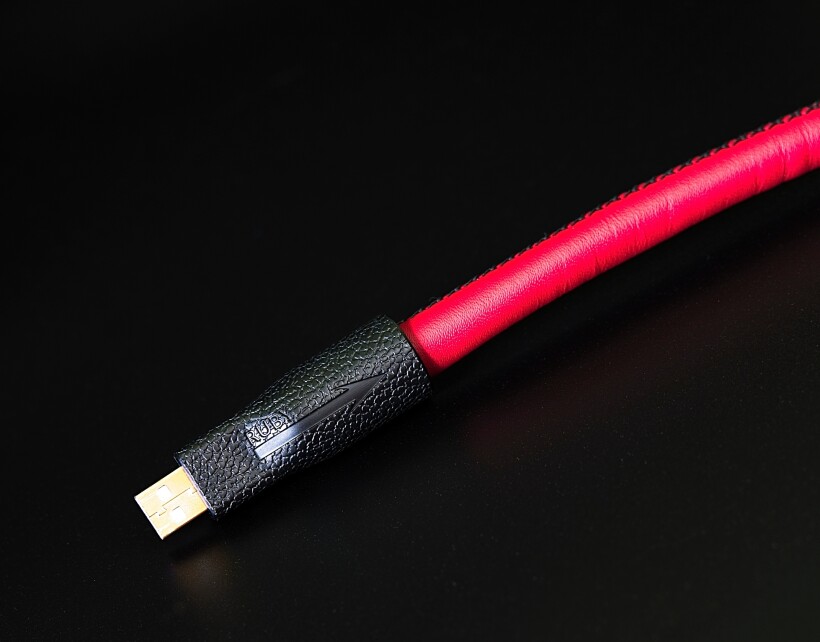
Although it is the piano in the recording that leads the band, the other musicians – drummer and bassist – have their chance to shine as well. These passages with them taking over, even more than other ones before, showed how perfectly controlled and defined is the sound with Ruby. One could hear perfectly the springiness of drums membranes and the hardness of the cymbals, and how well they were differentiated. It was not the fastest sound that I ever heard, but it was extremely energetic, full, well-balanced, with good proportions between the individual phases of each sound. The O-Zone Percussion Group album provided me with a similar or even more impressive experience because more percussion instruments were involved. I won’t get deeper into bass performance, as it was simply excellent, but I’d like to mention the low low end of the range, as this album features also timpani, that with Ruby was definitely more impressive, more powerful, and deeper sounding than with the Emerald. It was about the physical power and mass of its sound and even better differentiation of those highly energetic deepest sounds.
The treble with all the cymbals and other metal and wooden percussion elements playing in this range impressed me maybe even more than the low end. The number and variety of these elements once again emphasized Ruby’s fantastic resolution and differentiation, which in turn resulted in an extremely realistic experience. Of course, exquisitely reproduced, long decays suspended in the air and an extremely wide, but also deep stage did their part, too. The last aspect concerned, which is not so common, is the whole, impressive width of the soundstage. Often the depth is clearly shown in the listening axis, and towards the sides of the stage, it gradually disappears. With Ruby, the multilayered soundstage, the spatial relations between individual virtual sources, were shown equally convincingly not only between the speakers but also beyond their spacing. I must admit that I have never heard of such an effect with any other USB cable. However, I must remind you that I performed this test using the top JCAT USB XE card described in another review (see HERE), supported by the proprietary INITIO 3 power supply used in turns with Ferrum HYPSOS), and so far I had an opportunity to listen to only a few cables in this setup, among which it was the Ruby that was the most expensive one.  I have already mentioned that AC/DC and other rock bands also „participated” in my assessment of the Expression Ruby. With this type of powerful, electric sound, even at low volume levels, it was audible how perfectly the tested cable presents an energy of at least well-recorded music (after all, rock and its heavier versions do not belong to the canon of top-quality, audiophile recordings). Interestingly, I didn’t have to pump the volume up to enjoy such music. It was at reasonable and even at low volume levels that the David Laboga’s cable stood out from both, the Emerald and other USB cables I am familiar with. It is much more difficult to convey a high level of energy, drive, dynamics, and all the details while playing at lower volume levels rather than when walls tremble around us. Ruby kept me highly involved even at almost whispering levels while ensuring at the same time that the lesser aspects of these recordings, i.e. some sharpness or brightness of treble, slightly exaggerated compression of the material, or limited soundstage depth, did not spoil the fun. Such music is all about having fun, tapping the rhythm, rocking one’s head, playing imaginary guitar together with musicians, and screaming loud with vocalists. Ruby, while being such a resolved and refined cable, was still able to direct my attention to those aspects. The weaknesses of these recordings were still there, I could hear them if I wanted to focus on them or analyze sound, but they were unimportant when I was just having fun. If you want to do just that – have real fun when listening to your favorite music, Ruby will be ready to „rock” you in a highly addictive way.
I have already mentioned that AC/DC and other rock bands also „participated” in my assessment of the Expression Ruby. With this type of powerful, electric sound, even at low volume levels, it was audible how perfectly the tested cable presents an energy of at least well-recorded music (after all, rock and its heavier versions do not belong to the canon of top-quality, audiophile recordings). Interestingly, I didn’t have to pump the volume up to enjoy such music. It was at reasonable and even at low volume levels that the David Laboga’s cable stood out from both, the Emerald and other USB cables I am familiar with. It is much more difficult to convey a high level of energy, drive, dynamics, and all the details while playing at lower volume levels rather than when walls tremble around us. Ruby kept me highly involved even at almost whispering levels while ensuring at the same time that the lesser aspects of these recordings, i.e. some sharpness or brightness of treble, slightly exaggerated compression of the material, or limited soundstage depth, did not spoil the fun. Such music is all about having fun, tapping the rhythm, rocking one’s head, playing imaginary guitar together with musicians, and screaming loud with vocalists. Ruby, while being such a resolved and refined cable, was still able to direct my attention to those aspects. The weaknesses of these recordings were still there, I could hear them if I wanted to focus on them or analyze sound, but they were unimportant when I was just having fun. If you want to do just that – have real fun when listening to your favorite music, Ruby will be ready to „rock” you in a highly addictive way.
I left the so-called icing on the cake, that is vocals, for last. Already the Expression Emerald presented them in an engaging, sophisticated way, but also in this respect Ruby proved that the sound can always get better. Whether it was the coarse, rock voices of Brian Johnson, and Steven Tyler, sophisticated ones from jazz divas, such as Patricia Barber and Anna Maria Jopek, or finally the divine Luciano Pavarotti, David Laboga’s Ruby turned listening to them into a very unique experience. Each of them grabbed my attention with their charisma, roughness or smoothness of their voices, their power, energy, and wonderfully rendered timbres. With the classy, audiophile recordings, on top of all that, there was also a truly captivating sense of the presence of those vocalists, an impression of a close, almost direct contact.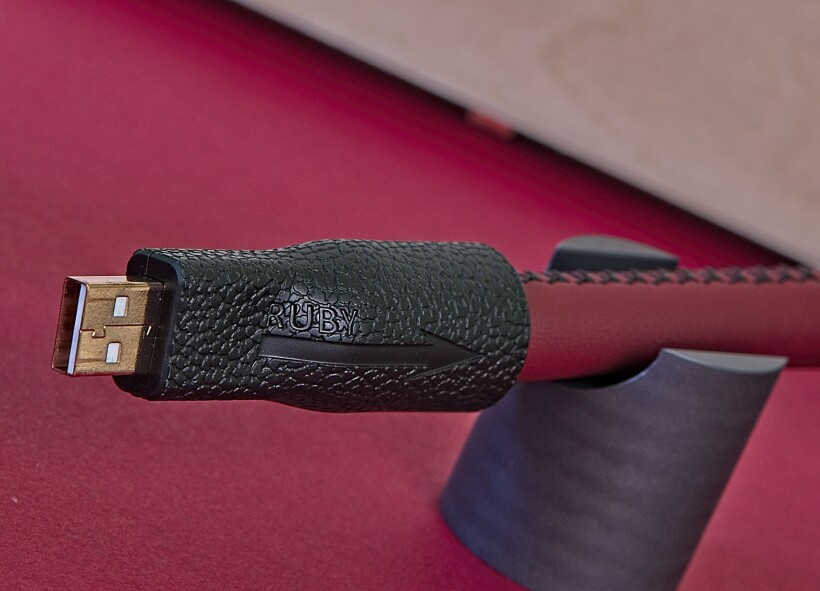
The operas with Pavarotti, or with my beloved Leontyne Price, were, in a sense, a condensation of almost all the advantages of Expression Ruby that I already described. Not only did the artists enchant me with the timbre and scale of their voices, their excellent technique, but also the spatial aspect of their performances – the aforementioned presence, excellently shown movements around the stage, the size of the latter, reverberation – everything unfolded in front of my eyes, so to speak, adding on to the realism of the performance. The outstanding resolution and separation contributed to the clarity of presentation, making it possible to follow any selected, even the smallest details of the performances of the best orchestras and singers in the world. The scale, energy, dynamics, and momentum of the presentation were amazing – after all, these are huge shows that must fit into a small listening room, but with Ruby, they boldly exceeded the limitations imposed by the walls and ceiling.
And finally, such large, complex performances with the tested cable were presented on the one hand in a perfectly ordered, fluid, coherent way, on the other hand, this perfect fidelity to the recordings also concerned the emotional layer, flawlessly showing the drama of the events taking place on the stage, building an atmosphere of the whole performance. All these elements smoothly came together to render impressive spectacles that grabbed my attention and kept me following the action as closely as only possible from the very first till the very last note. In my case, this type or class of experience is usually reserved for the best analog, in my case vinyl, setups. This time, my digital front end with the addition of the David Laboga Expression Ruby USB cable offered me a similar level of experience. It is something that does not happen every day.
Summary
From the moment the USB interface was discovered or adapted for audio purposes, efforts have been made to ensure that the non-physical medium, such as music files, could offer sound quality similar to that of physical media. It started with digital-to-analog converters with USB inputs and USB DACs, and then came the turn of USB cables and components whose task is to improve the quality of USB signal transmission. As files have been the second main music format for me, next to vinyl records, for many years, I have been following the progress of all these elements with great interest. Over the years I have been adding new components to my digital front end, replacing some with newer, higher quality ones, thus step by step getting closer to what my analog rig offers. The Expression Emerald cables were one such step, which was actually a surprisingly important one. Still, compared to Ruby, as it turned out now, it was not as big a step, as I thought it was. I still believe that they offer first of all a truly high-class sound and secondly excellent value for money, but it is clear that for the right price, one can purchase cables that have an even bigger impact on the digital system’s performance.
The much more expensive Expression Ruby does not revolutionize the sonic character of the system. It remains similar – it is still an extremely fluid, coherent, effortless, open, organic sound based on excellent resolution, differentiation, and dynamics. But each of these aspects is even “bigger / better / faster / more”. As a result, as long as the rest of the system matches Ruby’s class, because it is still only one of the many components that contribute to the final sound coming from speakers, what you hear is fabulously refined, organic, attention-catching, and highly expressive sound. The David Laboga Expression Ruby USB is an excellent, for now even the best USB cable I have had a chance to assess in my system so far, which makes the sound of digital files, firstly, absolutely non-digital, and secondly, in audiophile terms, simply excellent in virtually every aspect. It’s a great choice for high-end systems! That leaves me no choice but to (gladly) award it with our special award. 
Prices (when reviewed):
- David Laboga Expression Ruby USB (incl. VAT): 20cm : 2030 Eur; 50cm : 2202 Eur; 1m : 2448 Eur; 1,5m : 2694 Eur; 2m : 2940 Eur; 3m : 3186 Eur; (custom order) each additional 50cm : 308 Eur
Manufacturer: DL Custom Audio ; David Laboga
Associated equipment:
- Digital source: a passive, custom server with WIN10, Roon, Fidelizer Pro 7.10, JCAT NET XE, and JCAT USB XE cards with FERRUM HYPSOS power supply, KECES P8 (mono) linear power supply for the server, JCAT USB Isolator
- D/A Converter: LampizatOr Pacific +Ideon Audio 3R Master Time (USB signal regenerator)
- Analogue front end: J.Sikora Standard MAX turntable, J.Sikora KV12 tonearm, AirTight PC-3, phonostages: Grandinote Celio mk IV, ESE Lab Nibiru V 5.
- Power amplifiers: GrandiNote Shinai, Art Audio Symphony II (modified)
- Preamplifier: Audia Flight FLS1
- Loudspeakers: GrandiNote MACH4, Ubiq Audio Model ONE Duelund Edition.
- Interconnects: Hijiri Million, Hijiri HCI-20, TelluriumQ Ultra Black, KBL Sound Zodiac XLR, David Laboga Expression Emerald USB, David Laboga Digital Sound Wave Sapphire Ethernet
- Speaker cables: LessLoss Anchorwave
- Power cables: LessLoss DFPC Signature, Gigawatt LC-3
- Power: Gigawatt PF-2 MK2 and Gigawatt PC-3 SE Evo+; a custom power line with Gigawatt LC-Y in-wall cable; Gigawatt G-044 Schuko and Furutech FT-SWS-D (R)
- Racks: Base VI, Rogoz Audio 3RP3/BBS
- Anti-vibration accessories: ROGOZ-AUDIO SMO40 and CPPB16 platforms and ROGOZ AUDIO BW40MKII feet, Franc Accessories Ceramic Disc Slim Feet and Wood Block Platform





